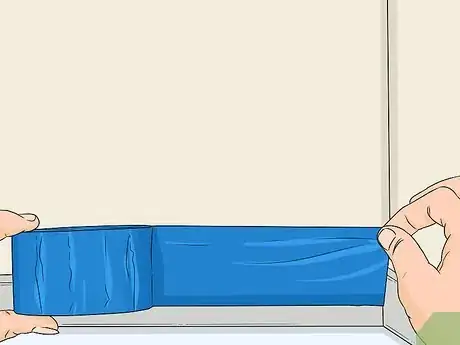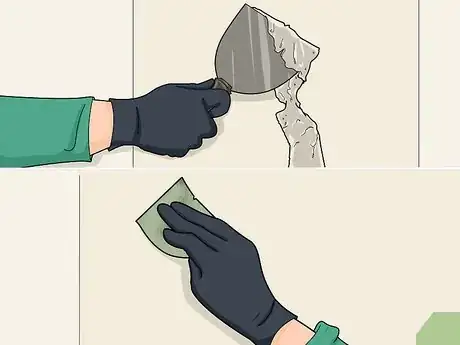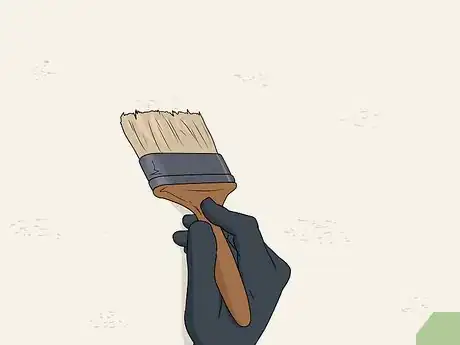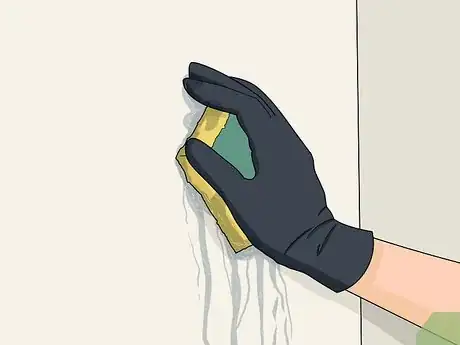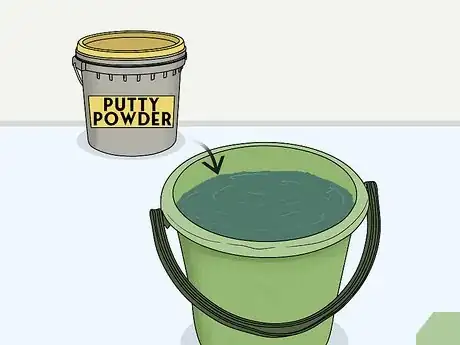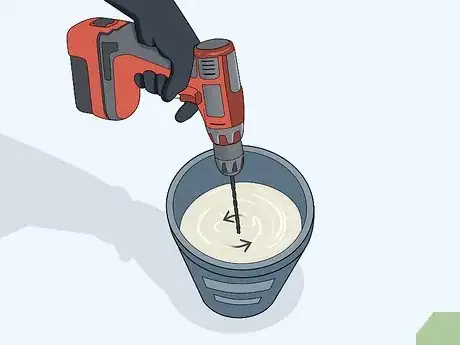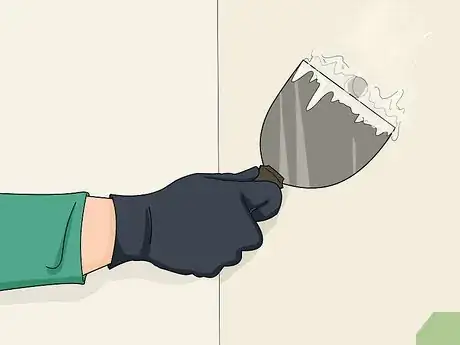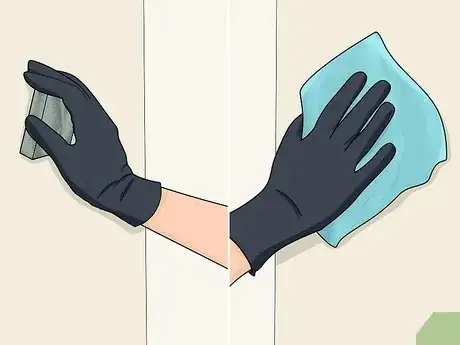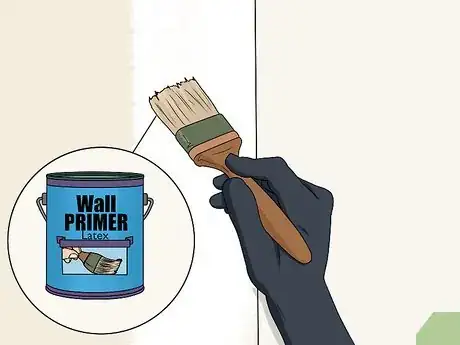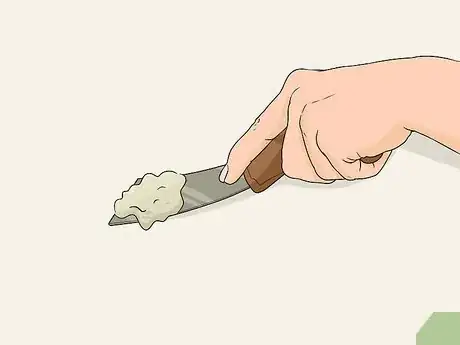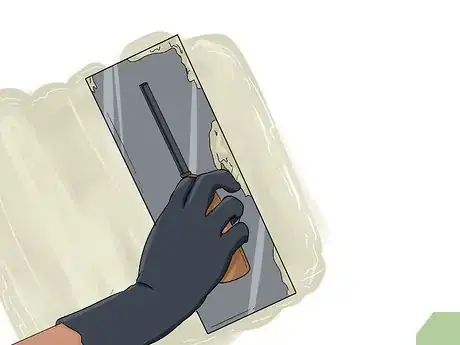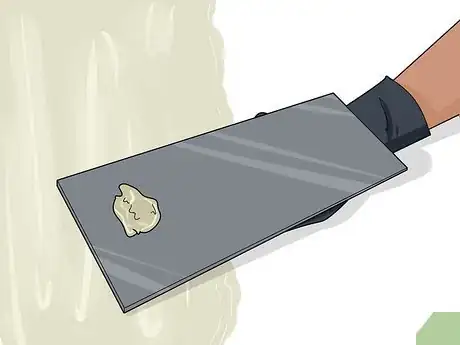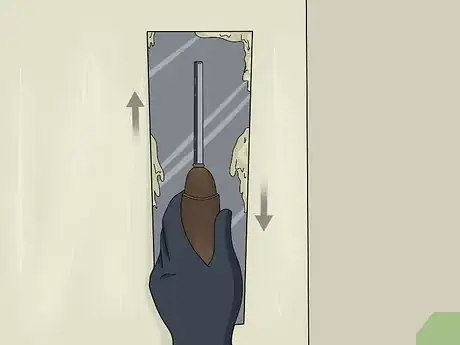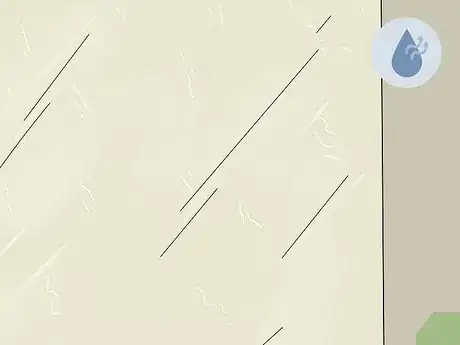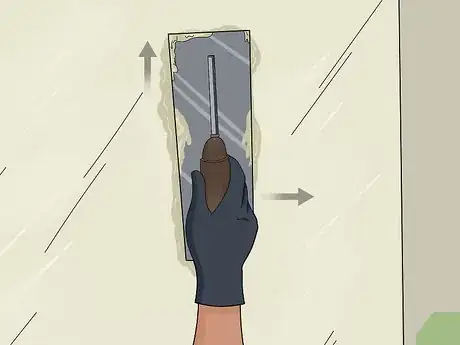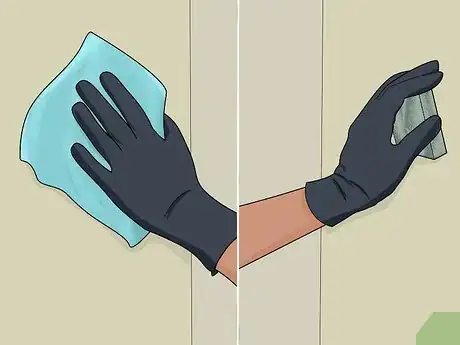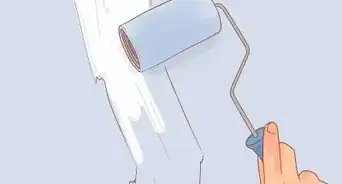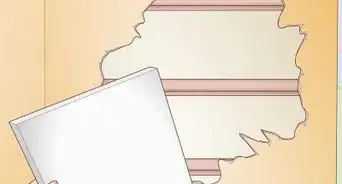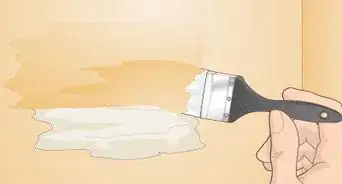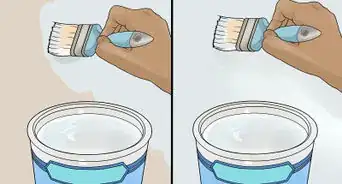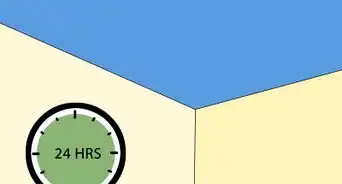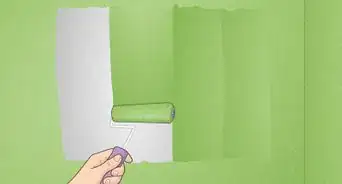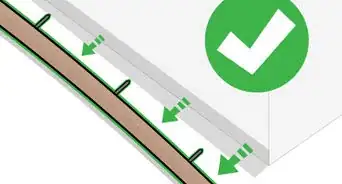This article was co-authored by Ryan Owsiany and by wikiHow staff writer, Christopher M. Osborne, PhD. Ryan Owsiany is a Drywall and Painting Specialist and the Owner of Patch and Paint Pros in Conshohocken, Pennsylvania. With over two decades of experience, Ryan specializes in interior and exterior house painting as well as drywall, plaster, and water damage repair. Ryan holds a BS in Industrial Engineering from Penn State University. Patch and Paint Pros only employ experienced, friendly painters that understand proper preparation is required to ensure client satisfaction on every painting project.
There are 7 references cited in this article, which can be found at the bottom of the page.
wikiHow marks an article as reader-approved once it receives enough positive feedback. In this case, 91% of readers who voted found the article helpful, earning it our reader-approved status.
This article has been viewed 109,007 times.
While there are many products, including joint compound and spackle, that can be used to patch or smooth out different types of walls, wall putty is particularly useful on plaster or concrete walls. Wall putty can fill in small cracks and holes, and adding a couple thin layers over the wall will improve its appearance and help paint adhere better. Just make sure you prepare the wall and mix the putty properly, apply it in thin coats, and let it dry thoroughly before proceeding.
Steps
Preparing the Wall, the Area, and Yourself
-
1Put on gloves, eye protection, and a breathing mask. While you’re cleaning and preparing the wall, you’ll create dust particles that can irritate your eyes and lungs. To be safe, keep your mask and eyewear on when applying the putty as well. Additionally, the mixed wall putty may be a skin irritant, so it’s best to wear gloves when applying it.
- Keep your protection on while you apply primer or paint as well, as even modern products can still release irritating fumes.
-
2Tape over or cover elements you want to protect. Use painter’s tape to mask over any items you can’t move but don’t want to cover in putty, such as door or window trim. If there is a finished floor below the wall, cover it with plastic sheeting or drop cloths.
- Taking a little time now to cover things up is much better than trying to remove wayward putty later.
Advertisement -
3Scrape off or sand down chips, flakes, and bumps. If you’re working with a new wall, you shouldn’t need to do much scraping or sanding. However, with older walls, use a paint scraper and/or coarse sandpaper (40-60 grit) to remove loose chips and flaking paint, primer or plaster. Use the sandpaper to also smooth out any bumps before proceeding.[1]
- If there are smaller cracks or holes in the wall—no more than about 0.5 in (1.3 cm) wide or deep—use a screwdriver blade to scrape out any loose material. Cracks or holes larger than this cannot be properly filled with wall putty and must be repaired using other methods.
-
4Use a dry brush over the entire wall. Brush the wall thoroughly to remove any remaining chips or flakes, as well as dirt and dust. Any clean, sturdy whisk brush will do the job well.[2]
- Keep your protective mask and eyewear on, because you’ll kick up dust while brushing.
-
5Wipe and moisten the wall with a clean sponge and water. Dip the sponge into your bucket of clean water, wring it out a little, and wipe over a section of the wall. Repeat the process until you’ve wiped the entire wall. The wall is now ready for putty.[3]
- Don’t worry if the wall is still damp when you start applying putty—this will only help it to adhere.
- You can also use a clean rag instead of a sponge.
Mixing the Putty and Patching Imperfections
-
1Add water, then the putty powder, to a bucket in a 2:1 ratio. Read the mixing instructions on your putty package to get the appropriate ratio for your product. Put the water in your bucket first, then add the correct amount of dry putty mix.
- Only mix an amount of putty that you can use within 2 hours, because it will become too hard to work with after that. If you’re not sure, err on the side of mixing less now and making an additional batch later.
- Help keep the putty moist while working by draping a damp towel over the top of the bucket.
- Dry-mix putty is cement-based and great for indoor or outdoor applications on plaster and concrete walls. Pre-mixed wall putty is acrylic-based and recommended only for interior use, particularly for repairs on painted walls.
-
2Stir it until it is thoroughly mixed and smooth. The fasted and easiest way to mix the putty is to use a stirrer attachment on a power drill, set at a low mixing speed. However, you can also use a stirring stick or similar manual implement. In any case, make sure the dry mix is thoroughly incorporated and that there are no lumps.[4]
- The putty should have a thick consistency, but not seem dry. If you pick up a scoop on a putty knife and hold it sideways, the putty should slide off in large globs.
- If necessary, alter the consistency by adding either more water or dry mix.
-
3Apply putty to small cracks and holes with a small putty knife. Scoop up some putty onto the blade of a small—roughly 3–4 in (7.6–10.2 cm) wide—putty knife and press the putty into each small crack or hole. Then scrape the blade over the area horizontally and vertically to remove excess putty.
- Use putty to fill cracks and holes that are no more than about 0.5 in (1.3 cm) wide or deep.
-
4Let the putty dry, then sand and wipe it. Give the putty at least 4-6 hours to dry, or even 12-24 hours in humid conditions. Then smooth it out by sanding over it lightly with fine sandpaper (300-400 grit), and wipe away any dust with a clean and slightly damp cloth.
- If the putty still looks or feels damp at all, wait longer before sanding it.
- Usually putty turns a lighter color when it's dry.[5]
-
5Apply primer to the repairs or the whole wall. Use a paintbrush to cover the patched areas with a coat of a primer that is suited to the conditions. For instance, if you’re working with an exterior concrete wall, use a primer made for that application.
- You may also want to cover the entire wall with a coat of primer. If you plan to apply putty to the whole wall now that you’ve made repairs, check the packaging to see if the putty manufacturer recommends priming a bare wall before applying the product.
- Even if you’re not going to add putty to the whole wall, you may want to prime the entire area before repainting it. This will help the patched areas to blend in better, and will also aid in paint adhesion.
Applying a First Coat to the Whole Wall
-
1Scoop up some putty with a small trowel and add it to a large trowel. Wall putty is usually applied with two flat-bladed trowels—essentially, larger putty knives—with one in each hand. The smaller trowel should have a blade that’s around 6–8 in (15–20 cm) wide, the larger one about 12–14 in (30–36 cm) wide. Use the small trowel to add a glob of putty to the large trowel.[6]
- Spread out the glob of putty along the blade of the large trowel so that it reaches nearly from end to end.
-
2Press the trowel blade to the wall at an angle and scrape it straight up. With the putty loaded onto the large trowel, touch its blade to the bottom of the wall at about a 30 degree angle. Maintain this angle and scrape the blade straight up the wall while maintaining contact with it. Leave behind an even coat of putty that’s about 0.125 in (0.32 cm) thick.[7]
- Go from the bottom to the top of the wall in one motion. If you can’t reach all the way up, go as high as you comfortably can and use a ladder to do the higher part of the wall later.
- Don’t expect to master this maneuver right away. Your putty might go on too thick, or it may be to thin and have missing patches on the wall. If there’s too much putty on the wall, scrape it all off and try again, this time applying more pressure to the blade. If there’s not enough, go over the area again with lighter pressure on the blade.
-
3Reposition the putty on your blade, or add more. Once you’ve applied a vertical stripe of putty on the wall, check the larger trowel blade. If it still has a sizable glob of putty on it, just use the small trowel to spread it out a bit if needed. Or, if you need more putty on the large blade, pick up some more with the small trowel.[8]
- With practice, you’ll be able to scrape the blades of your trowels quickly in order to add, remove, and reposition putty on them as needed.
-
4Keep scraping from bottom to top until you’ve covered the wall. Move to the right or left of the vertical strip of putty you just applied, and place your trowel at the bottom of the wall again. Overlap the previous stripe of putty with about one-fourth of the width of your trowel blade (e.g., 3 in (7.6 cm) for a 12 in (30 cm) wide blade). Apply a new stripe of putty in the same manner as the first one.[9]
- Just keep adding putty to your trowel as needed and repeating these stripes until the entire wall is covered.
- If you have some tighter spaces to cover, switch to using the small trowel to apply the putty to the wall.
-
5Allow the putty to dry for 16-24 hours. Wall putty needs to dry thoroughly between coats, so it’s best to leave it for a day before adding more putty (or doing anything else to the wall, like sanding or priming). In drier conditions, the putty may be dry in 16 hours, while it will take up to 24 hours in more humid conditions.[10] [11]
- To check for dryness, touch the putty with your fingers to feel for dampness, and look for darker areas that indicate remaining moisture.
Adding a Second Coat and Finishing the Wall
-
1Apply the second coat either horizontally or vertically. There are differing opinions on the best way to add the second coat of putty. Some people prefer to apply it vertically again, just like the first time. Others apply it horizontally, in the belief that it results in a smoother overall surface and less sanding work afterward. In either case, you’ll mix the putty, load it onto the trowels, and add it to the wall in the same thickness as the first coat.
- Horizontal application is really no different than vertical application, technique-wise. Keep the trowel blade at about a 30 degree angle and maintain contact straight across the wall.
- The second coat, like the first, should be no more than roughly 0.125 in (0.32 cm) thick.
-
2Sand and wipe down the putty after it dries for 16-24 hours. Once the second coat is fully applied and has dried thoroughly, go over the entire wall with fine sandpaper (300-400 grit). When you’re finished, wipe off any remaining dust with a damp cloth or sponge.[12]
- If you left some higher spots with your putty coats, sand these down with a coarse sandpaper (40-60 grit), then smooth them out with the fine sandpaper.
-
3Prime the whole wall, then add 2 coats of paint. Now that your wall putty job is finished, protect it with a coat of primer suited to the conditions (e.g., a primer made for exterior concrete walls). Add it to the wall with a paint roller and/or brushes, and let it dry as per the manufacturer instructions. Then, add 2 coats of paint in the same manner, allowing each coat to dry for the recommended time before proceeding.
- Even if you primed the whole wall before adding the putty, prime it again after applying the putty. This will add some protection to the putty and make the paint adhere much better.
Things You’ll Need
- Dry putty mix
- Clean water
- Large bucket for mixing
- Stirring stick or power drill stirrer attachment
- Putty knife
- 6–8 in (15–20 cm) and 10–14 in (25–36 cm) flat-blade trowels
- Coarse (40-60 grit) and fine (300-400 grit) sandpaper
- Sponge
- Primer, paint, and brush/roller
- Gloves, eye protection, and breathing mask
References
- ↑ https://youtu.be/7n_Y8L5wXXo?t=30s
- ↑ https://youtu.be/7n_Y8L5wXXo?t=30s
- ↑ https://youtu.be/7n_Y8L5wXXo?t=30s
- ↑ https://youtu.be/7n_Y8L5wXXo?t=50s
- ↑ Ryan Owsiany. Drywall & Painting Specialist. Expert Interview. 20 May 2021.
- ↑ https://youtu.be/7n_Y8L5wXXo?t=1m20s
- ↑ https://youtu.be/7n_Y8L5wXXo?t=1m30s
- ↑ https://youtu.be/7n_Y8L5wXXo?t=1m30s
- ↑ https://youtu.be/7n_Y8L5wXXo?t=1m30s
- ↑ Ryan Owsiany. Drywall & Painting Specialist. Expert Interview. 20 May 2021.
- ↑ https://youtu.be/7n_Y8L5wXXo?t=2m25s
- ↑ https://youtu.be/7n_Y8L5wXXo?t=3m20s
About This Article
Putty is a great material for smoothing out your walls and filling in cracks or holes. To get started, wipe your wall with a damp sponge to moisten it and help the putty stick. Mix 2 parts of water and 1 part of putty in a bucket and stir it until it’s smooth. If you’re only filling small cracks and holes, use a putty knife to apply the putty. Just scoop up some putty on your knife, press it into each crack or hole, and scrape away any excess. Wait at least 6 hours for it to dry, then sand it and wipe it with a damp cloth. If you’re applying putty to the whole wall, use a large trowel to save time and apply it in long, even strokes. Keep the trowel at a 30-degree angle and move it straight up the wall. Leave the wall to dry for 24 hours, then apply a second coat if you need to before priming and painting. For more tips, including how to protect door and window frames when you’re applying putty, read on!

